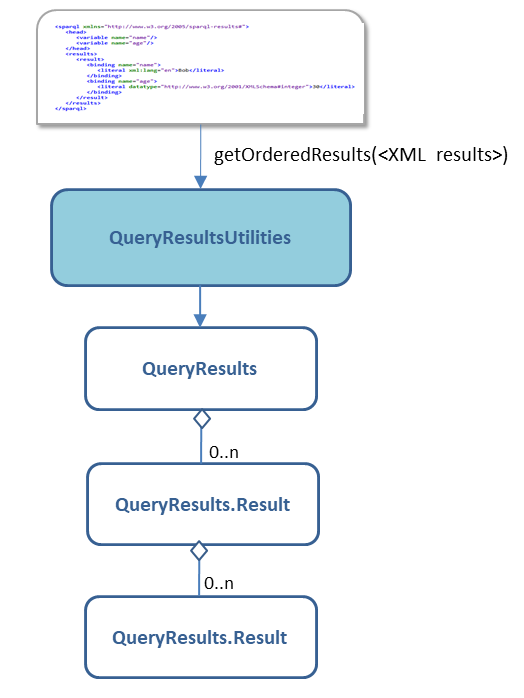QueryResults
1 Overview
2 QueryResults class
2.1 Results order
3 QueryResults.Result class
4 QueryResults.Value class
5 Examples
5.1 Basic example
5.2 Second example
6 See also
2 QueryResults class
2.1 Results order
3 QueryResults.Result class
4 QueryResults.Value class
5 Examples
5.1 Basic example
5.2 Second example
6 See also
The QueryResults class allows to decode the XML results of a SPARQL request.

The various static methods QueryResults instance create a QueryResults instance.
This class has the following methods:
This class has the following methods:
Overview
The result of a SPARQL request can be either:- A result formatted in JSON (see SPARQL 1.1 Query Results JSON Format)
- A result formatted in XML (see SSPARQL Query Results XML Format (Second Edition))
- A result formatted in CSV

The various static methods QueryResults instance create a QueryResults instance.
QueryResults class
The QueryResults class has the following methods:- The QueryResults.countResults() method return the number of results of the query
- The QueryResults.hasResults() method return true if there is at least one result for the query
- The QueryResults.getFirstResult() method return the first result for the query
- The QueryResults.getResults() method return all the results for the query. Note that it will return null if there are no results
- The QueryResults.getOrderedResultsList() method return the ordered result list. It will return an empty list if there are no results
- The QueryResults.getOrderedResult(int) method return the result for a specified index
Results order
The key of the result Map will be theSELECT variable used to order the result (by the orderedBy argument)). If this variable was not part of the SELECT variables, then it will be the first encountered variable in the columns.
QueryResults.Result class
The QueryResults.Result represent one result. It contains the Map of attributes for one result.This class has the following methods:
- The QueryResults.Result.getKey() method return the key of the result, corresponding to the variable returned in the result Map
- The QueryResults.Result.countValues() method return the number of values, which correspond to the number of variables declared in the
SELECTconstruct - The QueryResults.Result.getValues() method return the values for the result, corresponding to the list of variables declared in the
SELECTconstruct. The key of the Map is the variable name - The QueryResults.Result.getValue(String) method return the value for a specified key (ie variable name)
QueryResults.Value class
The QueryResults.Value class represent one value in a result.This class has the following methods:
- The QueryResults.Value.getValue() method return the associated value Object, which tyype depends on the type of the value (String, int, long, Boolean, etc...)
- The QueryResults.Value.getValueAsString() method return the value as a String
- The QueryResults.Value.getValueAsInt() method return the value as an int
- The QueryResults.Value.getValueAsLong() method return the value as a long
- The QueryResults.Value.getValueAsShort() method return the value as a short
- The QueryResults.Value.getValueAsFloat() method return the value as a float
- The QueryResults.Value.getValueAsDouble() method return the value as a double
- The QueryResults.Value.getValueAsBoolean() method return the value as a boolean
Examples
Basic example
Suppose the following query:SELECT ?number ?type WHERE { ?alarm rdf:type inav:Alarm . ?alarm inav:AlarmNumber ?number . ?alarm inav:hasAlarmType ?type . }The following code will print the
?number and ?type of each result:public void subscribe(ServiceInstance service) { QueryResults results = (QueryResults) service.getData("response").getValue(); Iterator<QueryResults.Result> it = results.getOrderedResultsList().iterator(); while (it.hasNext()) { QueryResults.Result result = it.next(); int number = result.getValue("number").getValueAsInt(); String type = result.getValue("type").getValueAsString(); System.out.println("Alarm " + number + ": " + type); } }
Second example
Suppose the following SPARQL XML result:<sparql xmlns="http://www.w3.org/2005/sparql-results#"> <head> <variable name="name"/> <variable name="age"/> </head> <results> <result> <binding name="name"> <literal xml:lang="en">Bob</literal> </binding> <binding name="age"> <literal datatype="http://www.w3.org/2001/XMLSchema#integer">30</literal> </binding> </result> <result> <binding name="name"> <literal xml:lang="en">Bobby</literal> </binding> <binding name="age"> <literal datatype="http://www.w3.org/2001/XMLSchema#integer">40</literal> </binding> </result> </results> </sparql>If we call:
QueryResults results = QueryResultsUtilities.getOrderedResults(<XML String>, true, "name");Wr will have two results:
- The first result is the element with the name "Bob"
- The second result is the element with the name "Bobby"
See also
- QueryResultsUtilities: This article presents the QueryResultsUtilities class
×
![]()
Categories: Queryresults